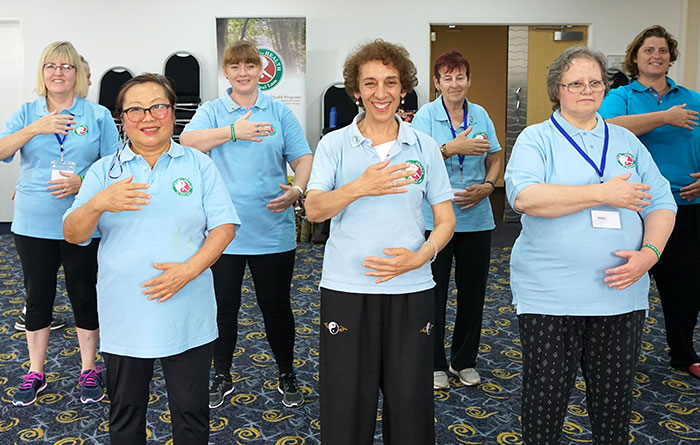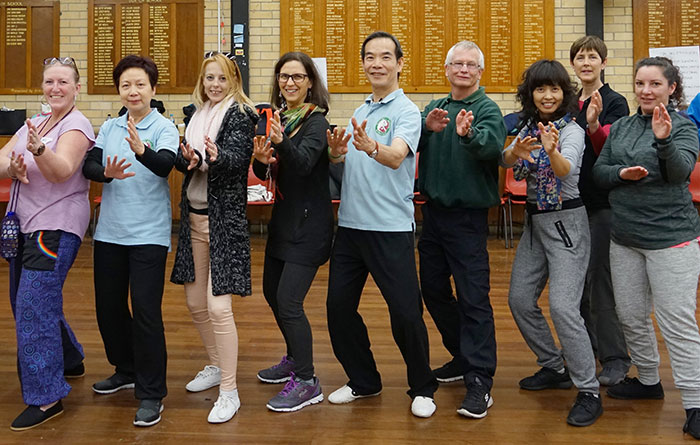Embracing Tai Chi in Healthcare: A Guide for Health Professionals

Introduction: Tai Chi for Health Professionals
Tai Chi, an ancient Chinese practice characterized by slow, graceful movements and deep breathing, is increasingly being recognized for its health benefits in modern healthcare. Known as “meditation in motion,” Tai Chi integrates physical activity with mindfulness, promoting overall well-being. There are over 500 studies showing that tai chi can improve practically all aspects of health.
Dr Paul Lam, a retired family physician and tai chi expert, has pioneered the integration of tai chi into healthcare. More than 30 published peer-reviewed medical studies have shown the many health benefits of his Tai Chi for Health programs. These programs are tailored to support health professionals in enhancing their own wellness and improving patient outcomes.
Today, Dr Lam’s programs are supported by the Centers for Disease Control and Prevention (CDC.gov), and health departments and arthritis foundations around the world.
What is Tai Chi?
Origins and Practice
Tai chi, originally a form of martial art, has evolved into a popular exercise for promoting health and wellness. It involves performing a series of movements in a slow, deliberate manner, combined with deep breathing and mental focus. The practice emphasizes balance, coordination, and the integration of mind and body, making it accessible to individuals of all ages and fitness levels.
Health Benefits of Tai Chi
Tai chi offers a wide range of health benefits that make it valuable in healthcare settings. These include:
- Improved Balance and Coordination: Tai chi enhances balance and stability, which is crucial for preventing falls, especially in older adults.
- Increased Flexibility and Strength: The gentle, continuous movements help improve flexibility and build muscle strength without the strain associated with more intense forms of exercise.
- Stress Reduction and Mental Clarity: Combining movement with deep breathing and mindfulness, Tai chi significantly reduces stress and promotes mental relaxation and clarity.
- Cardiovascular Health: Regular practice can improve cardiovascular function, lower blood pressure, and contribute to overall heart health.
- Chronic Disease Management: Tai Chi is effective in managing chronic conditions such as arthritis, heart disease, and diabetes by encouraging gentle physical activity and improving overall health.
For a detailed overview of Tai Chi and its principles, visit the Tai Chi for Health Institute’s page on tai chi.
Tai Chi for Healthcare Professionals
Broad Benefits and Integration
Tai Chi’s holistic approach addresses both the physical and mental aspects of health, making it an ideal tool for healthcare professionals. Dr Paul Lam’s Tai Chi for Health programs provide structured methods to incorporate tai chi into clinical practice, supporting both stress management and enhanced patient care.
“Taking care of your patients or clients can be stressful and can drain your energy. People complain to you all the time. Having worked as a general practitioner for forty years, whilst I felt fulfilment from helping people, it could also feel quite draining at times,” says Dr Lam.
“Tai chi is more than just an exercise; it’s a comprehensive system for managing health. It combines the physical, mental, and emotional aspects of well-being into one practice, which is why it’s so effective in healthcare settings.”
Tai Chi for Health Programs
“I have been practising tai chi for over 40 years to help me manage my own arthritis,” Dr Lam continues. “But when I started teaching tai chi, I discovered the importance of effective teaching methods based on the most up-to-date research and the importance of modernised tai chi, especially for therapeutic purposes. This is why I worked with teams of health professionals to create a series of Tai Chi for Health programs.”
These programs equip healthcare professionals with the skills to integrate tai chi into both their daily routines and patient care strategies effectively.

Aastasia Yianni, Registered Nurse and Certified Tai Chi for Health Master Trainer (center)
Tai Chi and Nursing
Managing Stress and Maintaining Health
Nurses, who often face high levels of stress and physical demands, can greatly benefit from practicing tai chi. Its calming effects and gentle exercises help manage stress and maintain physical health. Anastasia Yianni, a retired registered nurse and Master Trainer for the Tai Chi for Health Institute (TCHI), describes how tai chi transformed her routine:
“The nursing environment can often be stressful. It is paramount to look after our own health in order to be able to care for others more effectively. Calm and relaxed nurses have a positive effect on their patients and with the people they work with. Incorporating tai chi into my daily routine was a game-changer. It helped me start the day centered and calm, and provided a break that rejuvenated me during long shifts.”
“Nurses can benefit by incorporating the tai chi principles into their everyday lives for physical and mental well-being. For example, movements are done slowly, smoothly and continuously which immediately slows breathing creating a sense of calm. There is a focus on body alignment and weight transference and the muscles work efficiently to build up strength and balance – important for falls prevention. The mind is focused on what the body is doing which brings relief from stressful thoughts. There is a sense of internal quietness and tranquillity which enhance clarity of thought.
“In turn they can also use what they have learnt in tai chi to enhance the lives of the people under their care. I remember frequently helping patients shift their position in bed or whilst seated to help alleviate pressure to the skin and reduce the risk of breakdown of the skin in the form of pressure sores.
“Likewise, it is important to relieve the stress in our minds to reduce the risk of breakdown from anxiety and excessive worry. Tai chi when practiced regularly does that.”
Practical Applications for Nursing Practice
The Tai Chi for Health Institute has developed specific programs for nurses, focusing on exercises that can be easily integrated into their demanding schedules. These programs emphasize the importance of maintaining both physical health and mental clarity, which are crucial for providing high-quality patient care.
“Nurses can practice tai chi for a few minutes during breaks or before their shifts. This not only boosts their own well-being but also sets a positive example for their patients,” says Dr Lam. “It’s about finding balance in their demanding roles and promoting holistic health.”
Real-Life Impact: Anastasia’s Transformation
Anastasia’s involvement with the Tai Chi for Health programs significantly influenced her approach to patient care. She says being able to combine tai chi with nursing only made her love her profession even more.“The Tai Chi for Health programs changed how I approached patient care. I saw significant improvements in patients’ physical and mental health. Tai chi provides a safe, effective way to enhance people’s well-being,” she explains. As a Master Trainer, Anastasia now teaches these programs to other nurses and health professionals, helping them integrate Tai Chi into their practice and daily lives.

Hillary Simon, Physiotherapist and Tai Chi for Health Instructor (center) next to Dr Paul Lamf
Tai Chi for Physiotherapists
Physiotherapists have found tai chi to be a valuable tool for managing chronic pain and aiding rehabilitation. In her desire to achieve long-term results for her patients, Hillary Simon, a dedicated (and recently-retired) physiotherapist, knew it would take more than the physiotherapy sessions she had been offering. She eventually discovered the profound benefits of tai chi while searching for new ways to assist her patients.
After attending one of Dr Lam’s Tai Chi for Health workshops, she began incorporating tai chi into her therapy sessions, particularly for patients with chronic pain and mobility issues. With research showing that 1 in 5 Australians suffer with chronic pain, Ms Simon is determined to help as many people as possible.
“Tai chi is an effective exercise based on the laws of nature,” says Ms Simon. “It can be performed by people of all ages and abilities. For my patients with chronic pain, it was incredibly beneficial in helping them stay active without causing further pain or injury.”
Hillary Simon’s Success with Tai Chi
Hillary Simon’s journey with tai chi started when she was exploring effective methods to help her patients maintain activity despite chronic pain. She found that tai chi’s gentle, controlled movements and focus on breathing were ideal for her patients.
“Keeping active is one of the main principles of managing pain,” Ms Simon explains. “Tai chi’s slow, controlled movements and focus on breathing made it perfect for my patients. They not only experienced less pain but also gained better mobility and a sense of calm. The benefits of Tai Chi as developed by the ancient Chinese are now being proven through modern day medical studies.
“I have learnt that participants of all ages and physical abilities are on their own journey with their own personal goals. The physical and mental benefits are experienced by all that I have had contact with, at their own personal level. In my experience, the more effort and practice that is put in, the greater the benefits.”
One of her previous patients, suffering from severe arthritis, now practices tai chi daily and has seen significant improvements in pain and mobility. “It’s truly rewarding to see such transformations,” she shares.
But it’s not just her patients that enjoyed the benefits of tai chi.
“On a personal level, I have benefitted from improved posture and balance, as well as learning the mind-body connection concept of mental quietness or relaxation. The longer I practice my tai chi, the more I understand the benefit of all its principles. It is much more than a form of exercise. It is a way of living life.”
Tai Chi for Health Institute: Training and Certification
About the Tai Chi for Health Institute
Founded by Dr Paul Lam, the Tai Chi for Health Institute is dedicated to making tai chi accessible and beneficial for everyone, particularly health professionals. It offers a variety of programs designed to promote physical and mental well-being through tai chi. These programs are supported by extensive research and tailored to meet the needs of diverse populations, including those with chronic health conditions.
It also represents all certified instructors/leaders of Tai Chi for Health programs. Today, the Tai Chi for Health Institute has approximately 70 Master Trainers (MTs) who train instructors and around 100 Senior Trainers (STs) who assist and conduct skill development workshops. To date, over 40,000 instructors have been trained worldwide, plenty of whom are health professionals.
Becoming a Tai Chi for Health Certified Instructor
“Teaching tai chi can be a very effective form of therapy for yourself and your students, and is evidence-based,” says Dr Lam. “Teaching a suitable Tai Chi for Health program will help your clients to gain mental and physical health benefits, become happier and, just as importantly, it will revitalise you and make you healthier. You will also learn more about your clients from a different perspective. Being a health professional will give you an advantage to learn these programs.”
Healthcare professionals interested in bringing the benefits of Tai Chi for Health to their patients can pursue training and certification through the Tai Chi for Health Institute. The certification programs cover the core principles of tai chi, specific movements and techniques, and how to adapt these practices to suit various patient needs.
The certification process equips professionals with the skills necessary to confidently teach tai chi. With reasonable preparation of learning a Tai Chi for Health program through an instructional Tai Chi DVD or Online Tai Chi Lessons, then attending a live, interactive Tai Chi Instructor Training Workshop, you would learn and be certified to teach and help your clients.
Once certified, healthcare providers can lead their patients through tai chi exercises, enhancing overall care and wellness.
“Being a certified Tai Chi for Health instructor has allowed me to offer a unique and valuable service to my patients,” shares an instructor. “It has been incredibly rewarding to see the positive impact tai chi has on their lives.”
To explore becoming a certified Tai Chi for Health Instructor and to bring these benefits to your practice, visit How to Become a Certified Tai Chi Instructor.
Conclusion: The Future of Tai Chi in Healthcare
Tai chi offers a versatile and effective approach to enhancing health and well-being across various medical fields. For health professionals, integrating tai chi into their practices can lead to improved patient outcomes and personal wellness. Whether it’s helping physiotherapists manage chronic pain or providing nurses with a tool to combat stress, tai chi offers comprehensive benefits that align perfectly with the goals of modern healthcare.
Dr Paul Lam’s Tai Chi for Health programs provide the necessary training and support for health professionals to incorporate tai chi into their daily routines and patient care strategies. As more healthcare providers and patients experience its benefits, tai chi’s role in healthcare is set to grow, bringing ancient wisdom into contemporary medical practice.
Read More:
- Tai Chi for Arthritis and Fall Prevention – Recognized by the Centers for Disease Control and Prevention (CDC.gov)
- 35 Published Peer-Reviewed Medical Studies on Dr Paul Lam’s Tai Chi for Health programs
- How to Become a Board-Certified Tai Chi Instructor
- Medical Studies
- Dr Paul Lam’s Tai Chi for Health Programs
- Dr Paul Lam’s Workshop Calendar
- Tai Chi Instructor Training Workshops by Master Trainers
- Online Tai Chi Lessons
- Tai Chi for Health DVDs, Books and other products
